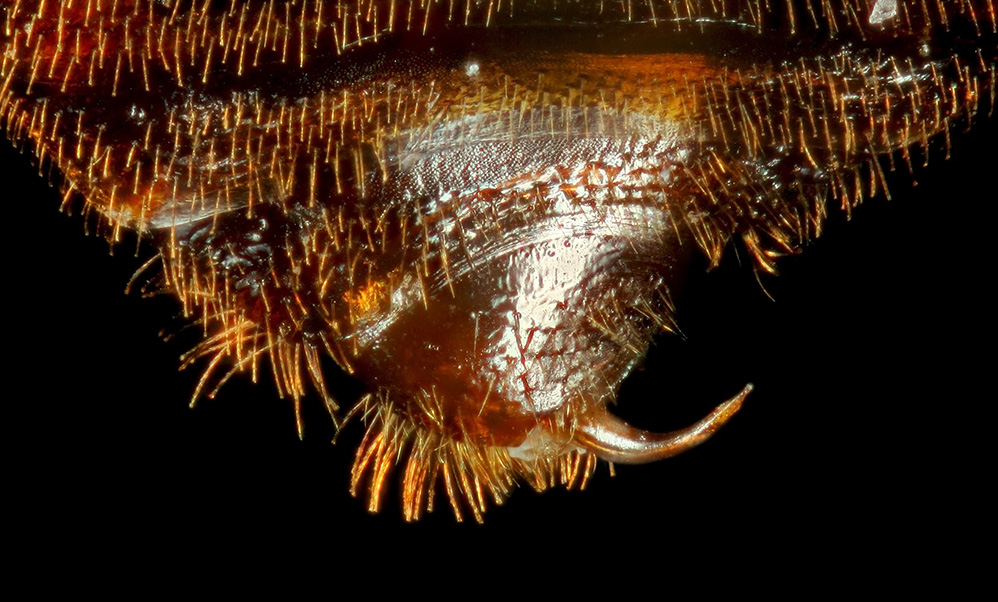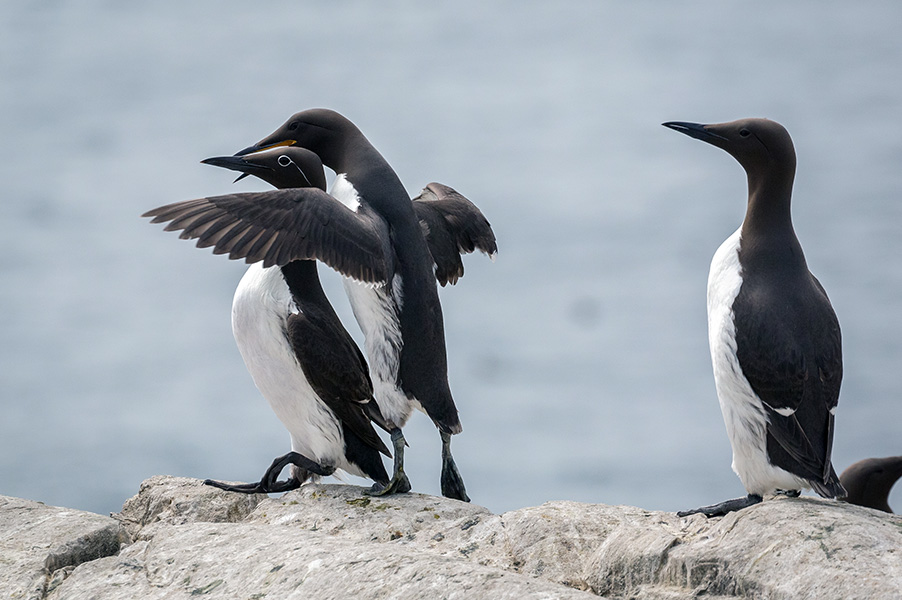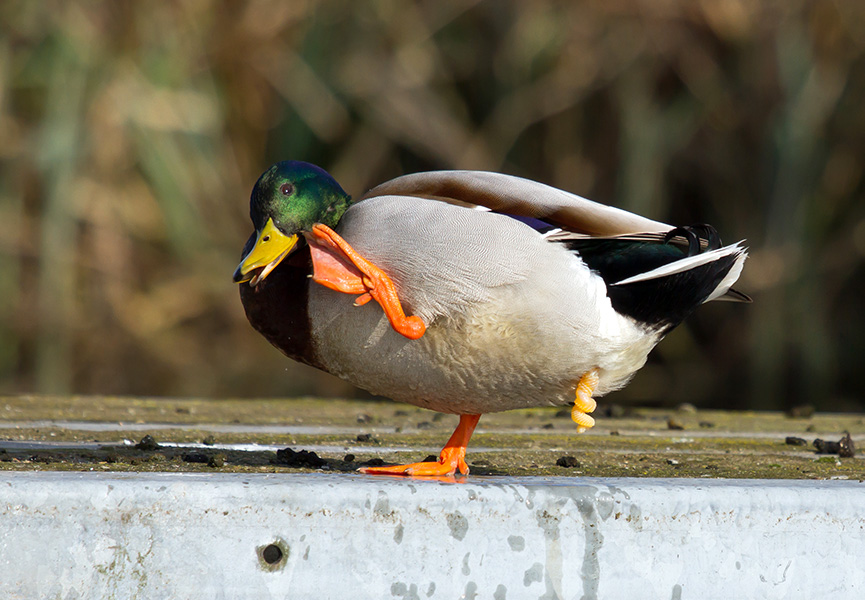On a spring day in 1965, 20-year-old biology student Geoff Parker found himself lying flat on his stomach in an English meadow, staring at a pat of cow dung and the frantic activities of dung flies around it. But this was far from a case of a student grudgingly accepting a somewhat unsavory project: Parker had jumped at the chance. “I’d spent a lot of time on a friend’s farm as a kid, and I knew these yellow dung flies well,” recalls Parker, now an emeritus professor at the University of Liverpool.
Parker noticed that as soon as a cow kindly deposited a new pat, male dung flies would come flying in, eager to mate. Females soon followed, alighting nearby. Within minutes, a male would grab hold of a newly arrived female, inject his sperm into her reproductive tract, then carry her back to the pat to deposit her eggs. All the while, he would fiercely fend off any other males trying to snatch her away.
Parker was fascinated, but before long he started worrying about the sheer waste of time — not his own, to be clear, but that of the dung flies. Even after mating was over, the males held on to the females. Why would they do that?
After all, males make many more of their tiny sperm than females produce eggs, so presumably they could father more offspring if they took off to find another mate right after insemination. Though he had always abhorred math, Parker decided to try to calculate the optimal time schedule for a male dung fly to maximize its reproductive success. He spent even more time around the pats through his PhD years, outfitting an old van with a bed so he could sleep near the meadow.
After plenty of pondering, it finally struck him: Males were not just competing for fertilization before mating. Competition continued afterward. If a female were to go on to mate with another male, the second male’s sperm might mix with — or even replace — the sperm of the first. Parker was even able to show that the last male to mate with a female fertilized at least 80 percent of her eggs.
What Parker had found cast new light on many other insect phenomena described in the scientific literature. Some males left plugs in the reproductive tract of females. Others were known to forgo the traditional route entirely, injecting sperm through the female’s abdominal wall. In 1970, Parker summoned the courage to propose a new explanation for these strange behaviors, in a paper titled “Sperm competition and its evolutionary consequences in the insects.” All these strategies, he proposed, had evolved to give the sperm of one male advantage over that of another.
Parker’s ideas were slow to take hold in the scientific community. But in recent decades, sperm competition has come to be accepted as the best explanation for many surprising and sometimes quirky adaptations. It has turned out to be important not just in insects, but also in spiders, fishes, reptiles, birds and mammals, inspiring hundreds of new studies every year.

The male bed bug’s sharp, talon-like penis allows him to forgo traditional mating. Instead, he inseminates a female through her abdominal wall, thereby reducing competition from other males’ sperm.
CREDIT: RICHARD NAYLOR
“A bit of a no-no to write about”
Parker’s ideas were a revelation to behavioral ecologist Tim Birkhead, now at the University of Sheffield, who heard about them as an undergraduate in 1971. “All the lights suddenly went on; it was an epiphany,” he says. “I just thought, ‘That’s what I want to do — I want to see whether what Parker has found in insects applies to birds.’”
Birkhead’s plans didn’t elicit a lot of enthusiasm from his contemporaries. “People said, ‘That’s a waste of time, because everybody knows birds are monogamous,’” he recalls. Yet when, in 1972, he was dispatched to the Welsh island of Skomer to study a colony of seabirds called guillemots for his PhD, it soon became obvious that males and females of that species would often sneak off to mate with individuals other than the one they’d paired with.
Like Parker before him, Birkhead started perusing the literature, looking for evidence of promiscuity in birds. But when those detailed descriptions of bird biology got to the part that he was interested in — sex — they often just brushed over it. “Despite the liberal sixties, it was still a bit of a no-no to write about it,” he says. So he started corresponding with other ornithologists to ask about mating outside of the pair, and many confirmed they had seen similar things.

Seabirds called guillemots often mate with birds other than the ones that they’ve paired with. Here, a male (middle) is attempting an extra-pair copulation with a female (left). The bird looking on (right) is unlikely to be the female’s partner because he is not trying to intervene.
CREDIT: ISTOCK.COM / ANDY_OXLEY
Starting in the late 1980s, the advent of genetic analysis put the final nail in the coffin for the idea of monogamy in birds, showing that in many species, males other than the one at the nest can father some of the offspring. Sperm competition, it appeared, is a concern for birds as well as insects. Birkhead and others have since documented many adaptations that make sense when viewed through that lens. Some males go to great lengths to guard females, for example, and species that often mate outside of a bonded pair produce larger and faster sperm. In waterfowl, intense sperm competition led to the evolution of large, spiraling penises, as well as vaginas with labyrinthine anatomy that help to prevent forced fertilization by unappealing males.
The conflict over which male gets to fertilize extends even to the molecules produced by creatures’ reproductive tracts. Scientists were surprised by studies, starting in the 1980s, reporting that sex peptide, a protein in seminal fluid, not only stimulates a female’s egg production but also lowers her eagerness to mate again, thereby reducing sperm competition.
And sex peptide was just the start. In a 2020 paper, evolutionary geneticist Mariana Wolfner of Cornell University and colleagues listed more than 300 proteins found in the seminal fluid of male fruit flies. Several of these, the scientists showed, have an influence on sperm competition — by affecting sperm storage, for example, or favoring one male’s sperm over another’s. Many of the other proteins may also be involved in sperm competition, the researchers suspect.
In mammals, there may be ten times as many different proteins in the semen, Wolfner adds; about a hundred are known to be similar to the proteins in fruit flies. Though their effects may differ in humans, it does suggest there is molecular potential for sperm competition in our species.

Female ducks have evolved contorted vaginas to resist forced insemination by unattractive drakes; drakes responded in kind by evolving long, twisted penises, such as the one on display in this photo of a mallard duck.
CREDIT: ISTOCK.COM / MICHAKLOOTWIJK
All sorts of sociocultural baggage
Research on human sperm competition is scant and controversial, says behavioral ecologist Leigh Simmons of the University of Western Australia. A former student of Parker, he has studied the extent and consequences of sperm competition in insects as well as mammals and a variety of other animals (read his 2005 overview of research on females mating with multiple males in the Annual Review of Ecology, Evolution, and Systematics).
One of the best indications of sperm competition may be the quantity of sperm that males of a species can produce. In studies with dung beetles and flies, Simmons and others have shown that if one eliminates sperm competition by preventing females from mating with multiple males, a decrease in the size of the testes often evolves. In the case of the dung beetle, the resulting male offspring evolved to produce fewer sperm, and thus sired fewer offspring themselves when multiple matings were allowed again.
And in studies with house mice, which are naturally promiscuous, enforcing monogamy — to prevent sperm competition — led to evolutionary changes in testes architecture; these caused a decrease in the amount of sperm produced by males in later generations.
In primates, too, species in which females mate with multiple males tend to have larger testes. Intriguingly, the relative size of human testes lies about halfway between that of chimpanzees, whose females mate with many different males, and gorillas, whose females often mate only with the dominant male. This suggests that for most of our evolutionary history, there may have been some sperm competition in humans, but not as much as in chimps.
Modern humans have reduced sperm competition through a variety of cultural practices. First, mate guarding was “perfected” with the introduction of social restrictions on sexuality, often aimed at women. On a more positive note, contraception reinforced the ability of women to choose who fathers their children. “There are all sorts of social and cultural baggage that make humans difficult to work with and interpret,” Simmons says.
And, he adds, “there are plenty of animals to work on, so why would you do it in humans?” He fondly remembers the first time he met Geoff Parker: “We went out into a meadow in the sunshine, and he showed me the yellow dung flies. We just played around for a couple of days, marking flies to see what they were doing. It was such a wonderful experience.”

Researchers Geoff Parker and Leigh Simmons stare at a cow pat in a British field.
CREDIT: PHOTO BY JOHN FITZPATRICK
Healthy competition
There is another kind of competition that human sperm almost certainly do engage in — one that was long neglected, says evolutionary biologist Simone Immler of the University of East Anglia in the UK. And that is competition between sperm cells in the ejaculate of the same male.
For a long time, Immler explains, scientists assumed that genes in sperm were largely inactive, because sperm DNA is so densely packed. Yet as scientists learned how to study this with more precision, even down to the level of individual cells, it has become clear that genes in sperm may in fact be active early on. For example, recent research with zebrafish, a popular aquarium species used widely in research, has shown that genetic differences between sperm from the same male can affect sperm lifespan, which may be a crucial determinant of their ability to fertilize an egg.
This could be a big deal. Sperm from the same male are not genetically identical: Since each sperm contains only 50 percent of a male’s genes, some sperm may be nearly identical to each other and some may be very different, Immler says. So if a certain gene variant helps a given sperm get to the egg first — or, conversely, stops it from making it there at all — that creates a whole new world of opportunities for natural selection to operate.
This kind of selection on sperm creates some potential conflicts. It might, for example, promote genetic variants that help sperm to succeed even if the offspring that result aren’t as healthy as ones that would have resulted had another sperm fertilized the egg. But based on her results with zebrafish and similar studies, Immler thinks the competition between sperm is often beneficial.
She has shown that zebrafish sperm that survive longer than other sperm in the same ejaculate produce hardier offspring after fertilization: ones that are more likely to reach adulthood, live long and healthy lives and produce many little zebrafish of their own. That might be, she says, because sperm containing some of the worst new combinations of genes, or perhaps genetic defects, are weeded out early on.
Could the same be true for human sperm? Immler does think that competition between sperm of the same male probably enhances fertility by ensuring that abnormal or malfunctioning sperm don’t get to fertilize the egg. A better understanding of the way that human sperm compete might help fertility doctors better screen sperm for in vitro fertilization, she adds.
“Obviously, there are situations where you don’t have much of a choice, and couples should have the opportunity to have a baby regardless,” she says. “But there is definitely room for improvement for many of these technologies.”




